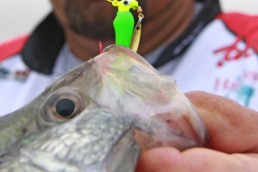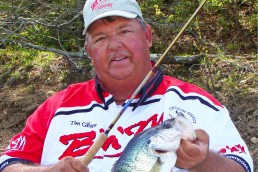Float Tactics for Spring Crappies
SHARE THIS POST
Watching a float disappear never gets old. It’s the way many of us learned to fish. Crappie fishing has evolved, with many high-tech techniques using multiple poles and fancy gear being the common standard. But float tactics are still effective for taking spring crappies.
Casting to wood on points
Crappies move based upon seasons and conditions. One spot they will likely be found in the spring is on a point. Points have a variety of depths where fish can move shallow or deep as needed. A variety of depths, along with some brush, stumps or other good cover, can be a good combination for success.
“Spring is a prime time,” says guide and tournament pro, Barry Morrow. “Crappies are slowly migrating to shallower water, so they stop at good resting spots where they ambush food. A shallow brush pile on a point is a good place.
“We are talking about brush or wood cover with 1 to 4 feet of water over the top. I’ll be using a lightweight, 1/16-ounce jig to give a slow fall under the float—something like a Beaver Bottom body—and work it really slow.
“If crappies are not up shallow, it’s time to work the sides or further out on the point where it is deeper. The float may still only be at four feet to work the sides of the submerged brush and stumps, but the overall depth may be 6 to 10 feet deep.”
Morrow says casting the float/jig combo is simple. Cast past the brush, bring it back rapidly, then stop it over the cover. The jig swings down from the float and to the cover. If a fish is there, he’ll nail it. There will be some hang-ups, but that’s part of the game.
He says another trick is to use a loop knot. It causes the jig to have more movement compared to a knot cinched tightly against the jig eye. It helps mimic a live but injured baitfish, making it deadly to a crappie looking for a meal.
Fancasting shallow flats
“The ideal situation,” says Morrow, “is to find a flat that has a ditch or a small channel in it. By staying 30 yards or more from the drop, you’ll be catching fish that are in transition to and from spawning sites. The water may be 2 to 4 feet deep. It warms quickly with a little sunshine.”
A 1/16- or 1/8-ounce jig under a float, preferably a weighted float, allows for long casts. Cast the jig, and then reel it back slowly with a pause every couple of feet. The pauses are excellent at creating more strikes. Long casts reach fish that might be spooky of a boat.
Are you enjoying this post?
You can be among the first to get the latest info on where to go, what to use and how to use it!
Spawning pockets
The backs of coves are predictable places for spawning. Rocks, gravel and grass can add to the attracting power. The jig/float or minnow/float combination should be thrown as close to the bank as possible. A little stain in the water is all that’s needed for a fish to get extremely shallow, especially if the sun is warming the water.
Morrow says that with any technique, precisely matching the float to the bait is important. It should take very little pressure, up or down, to move the float and indicate a bite. Keep on the move and adjust depths until you find the right level for fish activity. Get ready for fast action when the crappies are in shallow doing their spawning ritual.
Pitching to steeper spawning banks
“This is my favorite spot to fish during the spawn,” says Morrow. “I like to fish by pitching to the bank instead of casting, when the situation allows. Riprap, rock and rock/mud banks with a nearby channel are perfect areas.”
Morrow uses an 11-foot Todd Huckabee pole, 1/8-ounce jig and a slip-float. The long pole helps with the overall technique. A Thill Crappie Float stays against the jig during the pitching motion, adding to the pitching accuracy. A bobber-stop on the line sets the depth.
“The pitch is nothing more than swinging the bait back with the long pole and swinging it back forward. By keeping it about a foot off the water, a fisherman has great control, and it makes almost no splash when it hits the water. I’m usually fishing 1- to 3-feet deep water, with the float set at eight inches.
“This works on any bank crappies are using and on any stained waters. During high water, logs and limbs are excellent targets.”
Morrow says every situation is different, but crappies react similarly in most waters when it’s time to spawn. Staying away from fish and making a soft, silent pitch or cast can lead to good action. Fishermen wanting to use a minnow can catch fish too, but the presentations should be much slower, giving the minnow time to work. Keeping a lively minnow on the hook is important when using a float.
“This is a great time of year. Everyone should get out and enjoy warmer weather and good crappie action.”
Become a MidWest Outdoors Insider here!
MWO
SHARE THIS POST
Did you enjoy this post?
You can be among the first to get the latest info on where to go, what to use and how to use it!
Tim Huffman
Tim Huffman specializes in crappie fishing, is editor for two crappie magazines, as well as writing for several others. In 2018, he published his sixth book, Limiting Out for Crappie, available at Amazon. His first article appeared in MidWest Outdoors in 1988.



